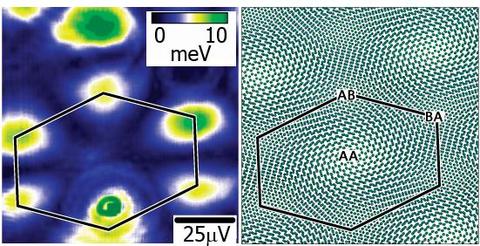
The world-leading graphene research team from the Georgia Institute of Technology and the CNST has taken yet another step toward elucidating the unique and often unexpected properties of this two-dimensional carbon material—which, because of its potential applications to sensors and other electronic devices, has received intense international interest and was the subject of the 2010 Nobel Prize in Physics. One of the most important measurement problems related to graphene has been determining how the structure of the material affects the movement of electrons. The team has now measured how magnetic field-induced electron orbits in epitaxial graphene are distributed spatially and are affected by rotations between different graphene sheets in the material. The researchers used a custom-built, low-temperature, high-magnetic field scanning tunneling microscopy system at the CNST to measure the detailed electronic structure across a multilayer graphene film on a silicon carbide substrate with atomic-scale spatial resolution. They found that the energy states follow contours of constant electric potential, and that there are energy gaps within isolated patches on the surface. These energy gaps create regions where electron transport is not allowed when subjected to high magnetic fields. The researchers proposed that the spatial dependence of the energy states is associated with the "moiré pattern" of atomic alignments that occurs when adjacent layers of graphene are rotated slightly from one to the next. The team's latest study raises a number of questions for future research, including whether the new phenomenon can be controlled, and how the observed effects may impact proposed carbon-based devices.
Real-Space Mapping of Magnetically Quantized Graphene States, D. L. Miller, K. D. Kubista, G. M. Rutter, M. Ruan, W. A. de Heer, M. Kindermann, P. N. First, and J. A. Stroscio, Nature Physics 6, 811-817 (2010).
[NIST Publication Database Entry] [Journal Web Site]

